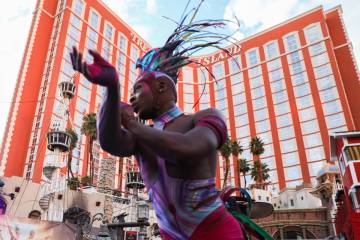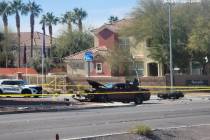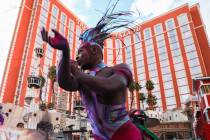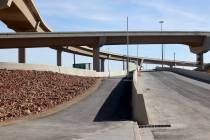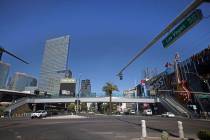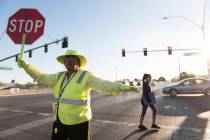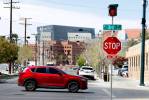There are laws, rules for sharing the road with bicyclists
There are reminders everywhere that encourage us to "share the road."
But some motorists out there seem to be oblivious that bicyclists exist, or that they should share the road with them.
Meanwhile, there are bicyclists on our streets who feel they're entitled to much more than just sharing.
Regardless of how you feel about people on bikes and whether you think they get more space than they deserve, laws mandate that people in cars give ground to those on bikes.
And it's about to get more crowded on downtown Las Vegas streets with the arrival of the first public bike-share program by late summer. There's a bike-share program in the 2,200-acre Cadence neighborhood of Henderson where 200 local residents share bikes. The Regional Transportation Commission of Southern Nevada is developing the downtown system.
Here are some of the rules of the road involving bicycles:
* Motorists are required to give bicyclists a 3-foot clearance when passing. That means even if a bicyclist is on the far-left side of a bike lane that already is 4 to 5 feet wide, people in cars must give 3 feet.
*When on multilane streets, a bicyclist is entitled to use one of those lanes. That means passing the cyclist in one of the other lanes. Standard vehicle passing laws exist when passing someone on a bicycle. In other words, a motorist must wait for a safe opportunity to pass.
*A bicyclist can use a travel lane when there are multiple lanes, but a motorist can't use a bike lane for travel except in some circumstances involving crossing traffic, emergencies or parking a disabled vehicle.
*Bicyclists must follow the same rules as motorists for driving at night, specifically, a white headlight at the front and red reflectors on the back and on the sides. A rear tail light does not eliminate the need for a reflector. The light must be on up to a half hour before sunrise and a half hour after sunset.
*Bicyclists can ride on the sidewalk. They're encouraged to go slowly around pedestrians and to dismount and walk when crossing streets in crosswalks.
*Bicyclists should ride in the direction of traffic. One of the key guides to bicyclists: Be predictable.
*Bicyclists are required to use hand signals for left and right turns and for slowing down.
A Warrior reader recently inquired about whether bicyclists are required to be licensed and, if not, how they contribute to paying for the maintenance of those nice green pathways that serve as bicycle lanes in downtown Las Vegas.
Jace Radke, a Las Vegas spokesman, said there are no licensing requirements.
"The city has been named a 'Bike Friendly City,' and I can tell you that the level of road wear and tear is significantly different for a car and a bicycle," Radke said.
Although fuel taxes pay for roads and highways in Southern Nevada, there are no special provisions for bicyclists to pay into the system.
"But many people who have bikes also have cars," said Ron Floth, bicycle outreach coordinator for the Regional Transportation Commission.
Some sales tax revenue is used for roads, so bicyclists contribute every time they buy a bike, helmet or replace a bike chain. Or buy lunch.
Floth added that when registering for a vehicle license, car owners have the option of paying an additional $2 into the "complete streets fund," which is dedicated to the concept of better landscaped, narrower roads with lower speed limits, bike lanes, wider sidewalks and improved crosswalks.
And soon, we'll see up to at least 180 more bikes cruising downtown streets.
The Regional Transportation Commission board approved the new bike-sharing program last month and is seeking community comments on where the 18 bike docking stations will be located.
Floth said it's something Waterloo, Wisconsin-based BCycle has had experience doing in the 40 cities it has set up bike-sharing.
For those unfamiliar with how a bike-sharing system works, a program participant buys a membership — the price hasn't been finalized yet, but it'll probably be around $60 to $85 a year — to have access to one of the dozens of sturdy Trek Bicycles across downtown. BCycle is expected to offer daily and multiday memberships, too.
A customer gets a key fob or card that will release a bike from a docking station and then has it for 30 minutes before it has to be parked in a docking station. Longer usage incurs a fee that would be charged to an on-file credit card.
Floth said the RTC is picking the bike-riding public's brains for the best locations for stations. The public can comment online through March 31 at the commission's website.
The stations are easy to move, so if the right spots aren't selected on the first try, it's just a three-hour job to move one.
Bicycles in the program will be confined to a 1½-square-mile area bordered by Interstate 15 to the west, U.S. Highway 95 to the north, Bruce Street to the east and Charleston Boulevard to the south. The southern boundary juts farther south from Charleston on Las Vegas Boulevard and Main Street to the Stratosphere area.
Some prospective users of the program are disappointed that bikes can't be taken farther south on the Strip. Floth said once the system has been road-tested, beginning at the end of summer, there may be some opportunities to expand.
But Floth is a little skeptical about bike traffic mixing with cars on Las Vegas Boulevard.
"When you drive or bike the Strip, you'd always be looking at the bright lights and the casinos," Floth said.
That's a little dicey, even if people on bikes legally have the right to use at least one of those Las Vegas Boulevard lanes.
Questions and comments should be sent to roadwarrior@reviewjournal.com. Please include your phone number. Follow the Road Warrior on Twitter @RJroadwarrior
■ Lanes of Sky Vista Drive will be disrupted for valve maintenance north of Charleston Boulevard through Monday.
■ Lanes of Torrey Pines Drive will be disrupted for valve maintenance between Big Pine Way and Smoke Ranch Road through Thursday.
■ Lanes of Tenaya Way will be disrupted for median maintenance between Cheyenne Avenue and Smoke Ranch Road through Thursday.
■ Several portions of Valley View Boulevard will be restricted for pothole maintenance through Friday. Affected areas include southbound between Frias and Le Baron avenues; at westbound Cactus Avenue; at eastbound and westbound Silverado Ranch Boulevard; southbound at Richmar Lane; and northbound and southbound at Serene Avenue.
■ Garces Avenue will be closed at Main Street for street improvements through Friday.
■ Lanes of Sahara Avenue will be disrupted for landscaping between Fort Apache Road and Diamondback Drive through Saturday.
■ Lanes of Elkhorn Road will be disrupted for a storm drain project between Fort Apache Road and Grand Canyon Drive through Feb. 16.
■ Lanes of Washington Avenue will be disrupted for a utility pole replacement at Pecos Road through Feb. 16.
■ Lanes of Bradley Road will be disrupted for sewer line work between Horse Drive and Brent Lane through Feb. 17.
■ Lanes of Far Hills Avenue will be disrupted for landscaping between Anasazi Drive and the 215 Beltway through Feb. 17.
■ Lanes of Grand Teton Drive will be disrupted for landscaping between Durango and Buffalo drives through Feb. 18.
■ Lanes of Bridger Avenue will be disrupted for road bed work between Ninth and 10th streets through Feb. 18.
■ Lanes of Deer Springs Way will be disrupted for general road improvements between Hualapai Way and Grand Canyon Drive through Feb. 22.
■ Lanes of Lamb Boulevard will be disrupted for power line work between Diamond Head Drive and Stewart Avenue through Feb. 22.
■ Traffic will be restricted on Fort Apache Road at Blue Diamond Road through Feb. 29 for a sewer line and manhole project. Traffic is shifted to the west half of Fort Apache with one lane open in each direction to 200 feet north of the Blue Diamond intersection. Work is planned , 7 a.m. to 3 p.m. Mondays through Fridays.
■ Restrictions will be in place through February on Lamb Boulevard between Wyoming Avenue and Vegas Valley Drive on a water pipeline rehabilitation project. Lamb will be reduced to one lane in each direction and left turns will be prohibited. Two lanes will be open in each direction during daylight hours. Work is scheduled 9 p.m. to 6 a.m. Sundays through Thursdays.
■ Fifth Street in North Las Vegas is closed between Cheyenne Avenue and Losee Road through February for the construction of an overpass route that will connect Fifth to East Carey Avenue.
■ Simmons Street is closed south of Craig Road for a water drainage project that will be completed in February.
■ Lanes of Cheyenne Avenue will be disrupted for sewer line work between Fort Apache Road and Buffalo Drive through March 1.
■ Robindale Road will be closed at Bermuda Road for sewer line construction with incremental road closures west to Gilespie Street through March 4. Construction will occur 6:30 a.m. to 3 p.m. Mondays through Fridays, and closures will remain in effect while work isn’t being performed. Property access will be maintained throughout the project.
■ The left lanes and shoulder of northbound and southbound Interstate 15 will be blocked at Milepost 117.5 in Mesquite through March 11 to prepare for construction of a highway interchange.
■ Lanes of Hualapai Way will be disrupted for landscaping work between Town Center and Alta drives through March 17.
■ Wigwam Avenue will be closed at various locations between Bermuda Road and Las Vegas Boulevard through April 15 for a sewer line improvement project. Work will start at Bermuda and move west a block at a time through completion. Property access will be maintained throughout the project.
■ The Stephanie Street bridge over U.S. Highway 95 will be closed through mid-April for construction. Traffic will be blocked in both directions and detoured to Russell Road or Galleria Drive.
■ Transit Route 109, the Maryland Parkway route, will be detoured because of road construction through April. Stops on George Crockett Road will not be served. Alternative stops are available on Routes 117 (Las Vegas Boulevard South and Silverado Ranch Road) and 217 (Warm Springs Road and downtown Henderson).
■ The ramp connecting Sunset Road to the southbound Airport Connector is closed through fall. Traffic lanes and shoulders will be restricted on the Airport Connector between Interstate 215 and the airport tunnel through mid-2016 for the construction of a flyover lane from the southbound connector to eastbound 215 Beltway.
■ Work will continue through the summer on a 13-mile paving project on Interstate 15 east of Mesquite. The project will run from the Nevada state line to the Virgin River Gorge and include improvements to the Littlefield bridge at Milepost 8. Work will occur 6 p.m. to 6 a.m. Mondays through Fridays. Work will begin on southbound lanes at the Littlefield exit.
■ Work is continuing through September on the installation of storm drains and relocating sewer lines, water lines and manhole covers, landscape removal and repairs and paving on Decatur Boulevard between Charleston Boulevard and Sahara Avenue. Sewer pipelines and manholes also will be rehabilitated on Oakey Boulevard between Rainbow and Martin L. King boulevards.
■ Work on the Regional Transportation Commission’s Flamingo Road Corridor Improvement Project will continue on the west side of Flamingo Road from Rainbow Boulevard to Hotel Rio Drive through fall.
■ Lanes of Main Street will be disrupted for general street improvements between Bonneville Avenue and Las Vegas Boulevard through Dec. 1.
■ A road widening project will delay traffic on Volunteer Boulevard from Executive Airport Drive to Las Vegas Boulevard and Executive Airport Drive will be repaved from Volunteer to St. Rose Parkway.The project will run through February 2017.
Gasoline prices
The average gasoline price Friday in the Las Vegas Valley was $2.24 per gallon. It was $2.24 in Nevada. The national average of $1.74 is down 7 cents from a week ago, down 26 cents from a month ago and down 41 cents from a year ago.
Las Vegas Review-Journal







